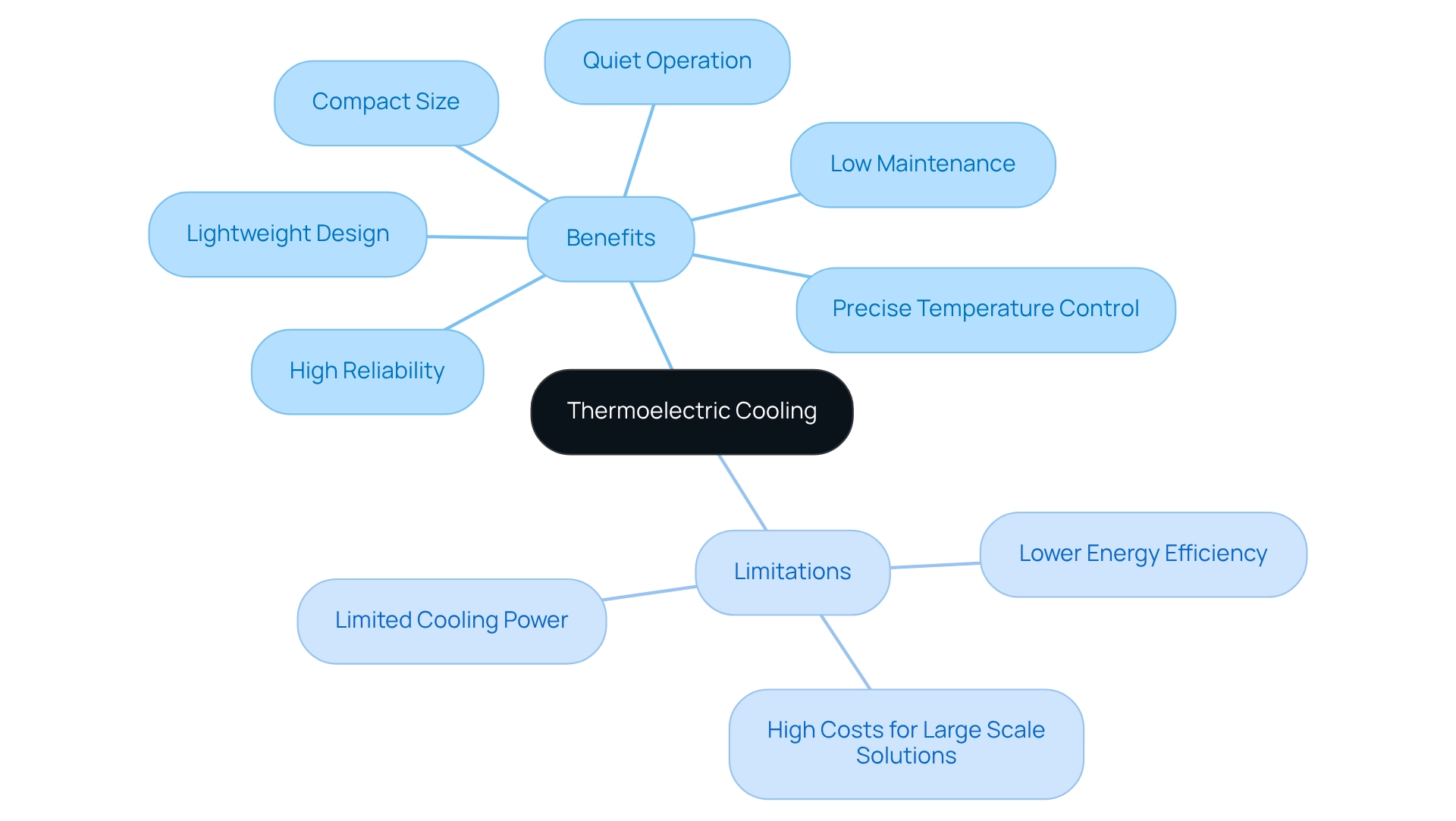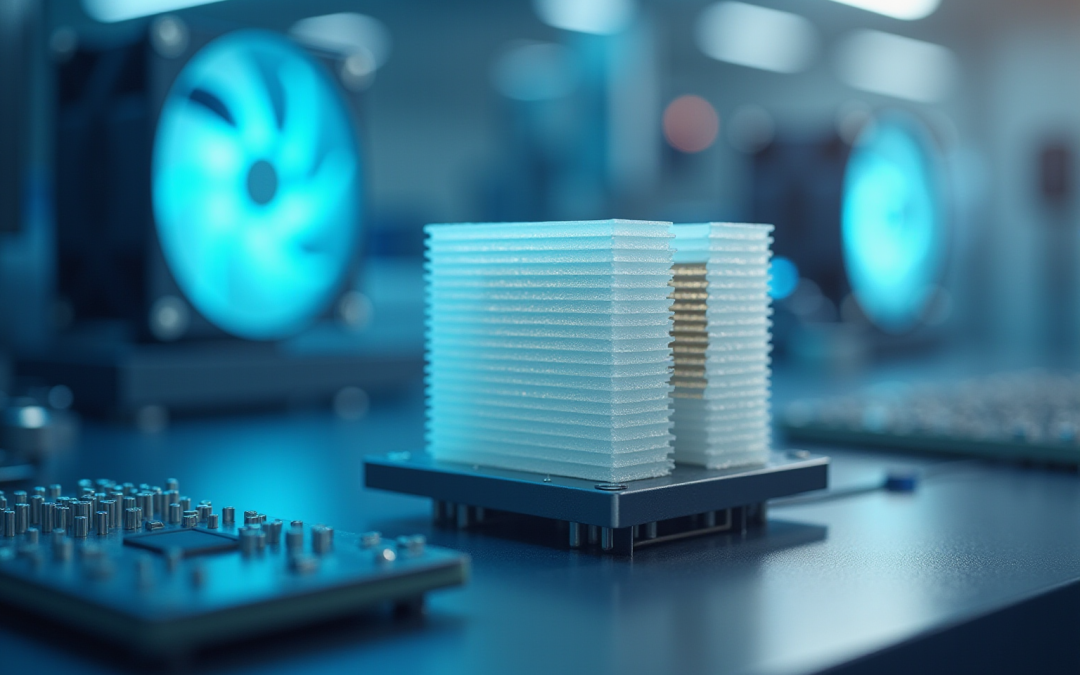Overview
Thermoelectric cooling operates on the principles of the Peltier effect, facilitating heat transfer between two semiconductor materials to create a cooling effect devoid of moving parts or refrigerants. This technology showcases remarkable efficiency and reliability across various applications, notably in the electronics and automotive industries.
However, it is essential to acknowledge its limitations, particularly its lower energy efficiency when compared to traditional refrigeration methods. Understanding these aspects is crucial for leveraging thermoelectric cooling effectively in relevant fields.
Introduction
In an era where temperature control is crucial across diverse industries, thermoelectric cooling technology stands out as a revolutionary solution. By harnessing the Peltier effect, this solid-state cooling method presents a distinctive approach to heat management, effectively eliminating the reliance on traditional refrigerants and mechanical components.
From boosting the performance of electronics to transforming automotive comfort and medical refrigeration, thermoelectric coolers (TECs) are demonstrating remarkable versatility and efficiency.
As advancements in materials science continue to drive this technology forward, grasping its principles, benefits, and applications is vital for fully leveraging its potential in a rapidly evolving landscape.
Define Thermoelectric Cooling: Principles and Mechanisms
Thermoelectric cooling is a cutting-edge, solid-state temperature regulation technology that utilizes the Peltier effect to transfer heat from one side of a thermal module to the other. When an electric current traverses two distinct types of semiconductor materials—typically p-type and n-type—it creates a temperature differential at the junctions. This phenomenon results in a cooling effect on one side and a heating effect on the opposite side. Such principles facilitate precise temperature control without the need for moving parts or refrigerants, making thermoelectric cooling both highly efficient and reliable for a myriad of applications in electronics.
Gagner-Toomey Associates stands out as the world’s largest provider of thermal management solutions, offering a comprehensive array of innovative refrigeration technologies. Their offerings include custom thermoelectric cooling solutions, heatsinks, fans, and blowers tailored for electronic applications and beyond. With a profound expertise in developing integrated temperature regulation systems, Gagner-Toomey Associates ensures superior performance and efficiency across various environments, solidifying their status as a pivotal player in the thermal management sector.
Trace the Evolution of Thermoelectric Cooling Technology
The concept of refrigeration through temperature differentials traces its origins to the early 19th century, marked by Jean Charles Athanase Peltier’s discovery of the Peltier effect in 1834. However, it was not until the mid-20th century that practical applications began to materialize. The advancements in semiconductor materials during the 1950s and 1960s played a crucial role in the development of efficient energy conversion modules. Over the decades, significant progress in materials science—particularly with the introduction of bismuth telluride and various alloys—has markedly enhanced the performance and efficiency of thermoelectric cooling systems. This evolution has led to their extensive adoption across diverse industries today.

Evaluate the Benefits and Limitations of Thermoelectric Cooling
Thermoelectric refrigeration presents notable advantages that capture attention: its compact size, lightweight design, and the absence of moving components contribute to low maintenance needs and high reliability. These characteristics not only enhance operational efficiency but also facilitate precise temperature control and quiet operation, making thermoelectric coolers (TECs) particularly suitable for sensitive applications.
However, it is crucial to acknowledge the limitations associated with TECs. Their energy efficiency is generally lower compared to traditional refrigeration methods, and the costs for large-scale temperature control solutions can be prohibitive. Consequently, these factors may restrict the application of temperature-regulating systems in scenarios where substantial cooling power is essential. Understanding these dynamics is vital for effectively leveraging thermoelectric cooling in the appropriate contexts.

Explore Applications of Thermoelectric Cooling Across Industries
Thermoelectric cooling is increasingly pivotal across diverse industries, showcasing its versatility and effectiveness. In the electronics sector, Peltier coolers (TECs) are essential for maintaining optimal performance in microprocessors and laser diodes, significantly extending their operational lifespan. For instance, the Cooler Master thermoelectric AIO CPU cooler features a 360mm radiator, illustrating the use of TECs in high-performance computing environments. The automotive sector has also adopted TECs, employing them for innovative applications such as seat ventilation and battery thermal control, which not only enhance passenger comfort but also improve battery efficiency and lifespan. As Hideo Tanimoto, President, noted, “We can also accommodate size adjustments to match the customer’s application and casing requirements, providing a versatile solution for a wide range of automotive and other temperature control needs.”
In the medical field, electronic cooling plays a crucial role in portable refrigeration systems for vaccines and biological samples, ensuring precise temperature control essential for preserving sensitive materials. The demand for thermoelectric components is on the rise, particularly in consumer electronics, where the integration of thin film units in wearable gadgets and smartphones is anticipated to drive significant growth. According to a recent case study titled “Emerging Trends in Thermoelectric Module Applications,” the consumer electronics segment is projected to experience the highest growth rate due to the increasing adoption of these modules. Furthermore, the applications of thermal management technology are expanding into IoT security devices, further demonstrating its broad significance. As industries continue to explore the potential of thermoelectric cooling solutions, its adaptability and efficiency are poised to foster further innovations and applications in emerging sectors.
Conclusion
The exploration of thermoelectric cooling technology underscores its transformative impact across various industries. By leveraging the Peltier effect, thermoelectric coolers (TECs) provide a reliable and efficient method for temperature management, effectively eliminating the need for traditional refrigerants and mechanical components. This solid-state cooling approach not only enhances the performance of electronics but also finds significant applications in automotive comfort and medical refrigeration, showcasing its remarkable versatility.
The evolution of thermoelectric cooling has been propelled by advancements in materials science, leading to the development of efficient semiconductor materials. While TECs present numerous benefits—such as compact design, low maintenance, and precise temperature control—they also encounter challenges, including lower energy efficiency and higher costs for large-scale applications. Understanding these dynamics is crucial for industries contemplating the adoption of this technology.
As the demand for thermoelectric solutions continues to expand, particularly in consumer electronics and IoT applications, the potential for innovation remains vast. The ongoing advancements in thermoelectric cooling not only promise enhanced efficiency and adaptability but also position this technology as a key player in the future of temperature management. Embracing these advancements will be essential for industries aiming to optimize performance and drive sustainable growth in an ever-evolving landscape.
Frequently Asked Questions
What is thermoelectric cooling?
Thermoelectric cooling is a solid-state temperature regulation technology that uses the Peltier effect to transfer heat from one side of a thermal module to another, creating a cooling effect on one side and a heating effect on the opposite side.
How does thermoelectric cooling work?
It works by passing an electric current through two different types of semiconductor materials (p-type and n-type), which generates a temperature differential at the junctions, allowing for precise temperature control without moving parts or refrigerants.
What are the advantages of thermoelectric cooling?
The advantages include high efficiency, reliability, and the ability to provide precise temperature control without the need for moving parts or refrigerants.
Who is Gagner-Toomey Associates?
Gagner-Toomey Associates is the world’s largest provider of thermal management solutions, offering a wide range of innovative refrigeration technologies, including custom thermoelectric cooling solutions, heatsinks, fans, and blowers.
What types of products does Gagner-Toomey Associates offer?
They offer custom thermoelectric cooling solutions, heatsinks, fans, and blowers tailored for electronic applications and beyond.
What is the significance of Gagner-Toomey Associates in thermal management?
Gagner-Toomey Associates has profound expertise in developing integrated temperature regulation systems, ensuring superior performance and efficiency across various environments, making them a key player in the thermal management sector.

